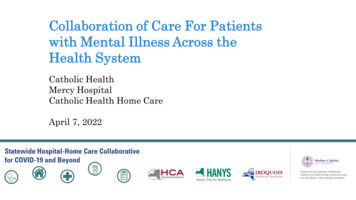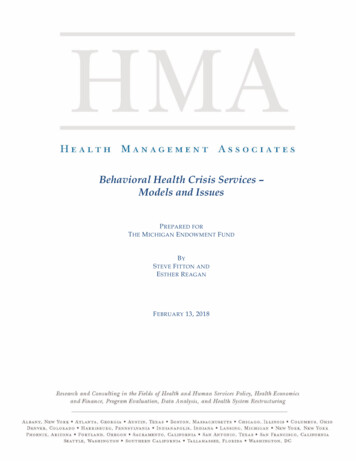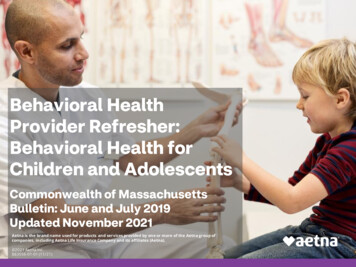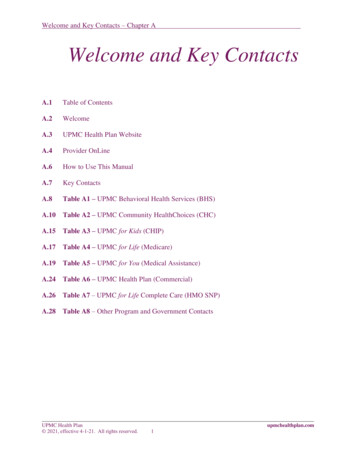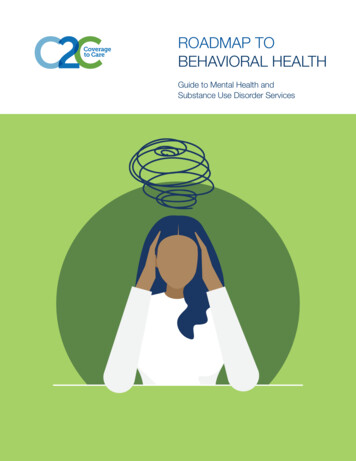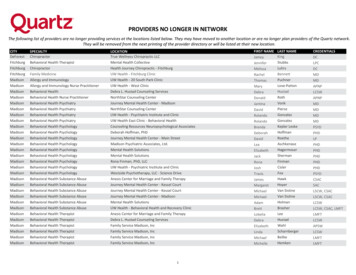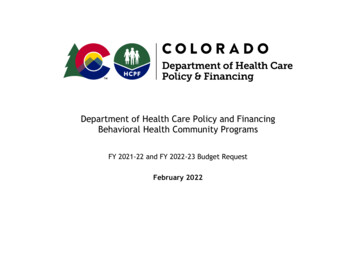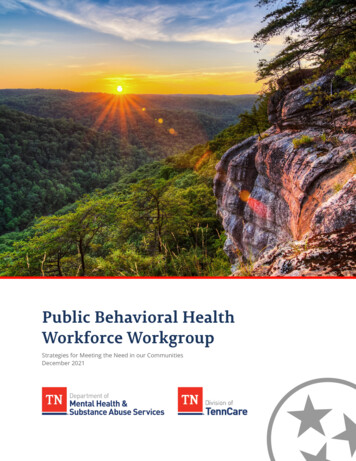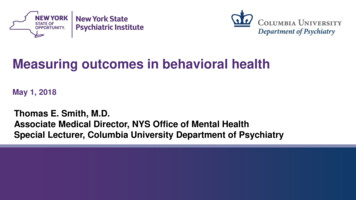
Transcription
Measuring outcomes in behavioral healthMay 1, 2018Thomas E. Smith, M.D.Associate Medical Director, NYS Office of Mental HealthSpecial Lecturer, Columbia University Department of Psychiatry
2Goals for Today Know the behavioral health measures used in NYSMedicaid programs Understand how to translate system levelmeasurement initiatives into agency level activities Learn about functional needs measures forindividuals with serious mental illness in NYS
3Why do we measure quality and performance?Short Answer: Health care has become increasingly expensiveand we’re not getting the outcomes that we want.
4Health care spending as a percentage of GDP, 1980-2013
5Health Care Quality, Spending, and Social/SDH Spending5
6Leading to focus on quality of health careInstitute of Medicine: Crossing the qualitychasm: a new health system for the 21stcentury. Washington, DC: NationalAcademies Press, 2001Berwick et al: The Triple Aim: Care, Health, And Cost. Health Affairs 27, no.3(2008):759-769; doi: 10.1377/hlthaff.27.3.759
7Impact of behavioral health conditions on health care costs and outcomesSource: Roehrig C. Mental Disorders Top the List of the Most Costly Conditions in the United States: 201 Billion. Health Aff 15.1659
8Utilization and spending by Medicaid enrollees withbehavioral health diagnoses, 201120%48%Enrollees with a BH diagnosisSpending for enrollees with a BH diagnosisEnrollees with no BH diagnosisSpending for enrollees with no BH diagnosisOne in five Medicaid beneficiaries had behavioral health diagnoses but accounted for almost half of total Medicaid expendituresSource: MACPAC.gov, Chapter 4: Behavioral Health in the Medicaid Program – People, Use, and Expenditures, June 2015 Report to Congress on Medicaid and CHIP, Medicaid andCHIP Payment and Access Commission, People-Use-andExpenditures.pdf
9Federal programs resulting from legislationKey programs authorized by legislation: Pay-for-Value programs for hospitals and physiciansoPhysician and Hospital Quality Reporting SystemsoValue-based modifier Bundled payments Meaningful use for Electronic Health Records (EHRs) Accountable Care Organizations (ACOs):o2012: Medicare Shared Savings and Pioneer Programso2017: Shared Savings Tracks 1, 2, or 3 CMS will tie 85% of all Medicare fee-for-service paymentsto quality or value by 2016 and 90% by 2018
10Accountable Care Model
11Why do we measure quality and performance?1. Monitor and understand systems, providers, and populations2. Internal Quality Improvementa. To support point-of-care decision makingb. For provider continuous quality improvement projectsc. Managed care organization performance improvement3. Accountabilitya. Public reportingb. Value-based payment
12NYS Behavioral Health (BH)Performance Measures
13NYS Medicaid ProgramQuality and Performance Measurement Medicaid Managed Care: Quality Strategy andQuality Assurance Reporting Requirements (QARR) DSRIP Performance Measures Value-Based Payment Program and Roadmap Behavioral Health Clinical Advisory Group (BH CAG)
14Measure NameHARP VBP Quality Measure Set(1/3)Measure StewardNQF Measure IdentifierClassificationNCQA2372Cat 1 P4PNCQA0032Cat 1 P4PIPCBreast Cancer ScreeningIPCCervical Cancer ScreeningIPCChlamydia Screening for WomenNCQA0033Cat 1 P4PIPCColorectal Cancer ScreeningNCQA0034Cat 1 P4PIPCComprehensive Diabetes Care: Eye Exam (retinal) PerformedNCQA0055Cat 1 P4PIPCComprehensive Diabetes Care: Foot ExamNCQA0056Cat 1 P4RIPCComprehensive Diabetes Care: Hemoglobin A1c (HbA1c) Control ( 8.0%)NCQA0575Cat 1 P4RIPCComprehensive Diabetes Care: Hemoglobin A1c (HbA1c) Poor Control ( 9.0%)NCQA0059Cat 1 P4PIPCComprehensive Diabetes Care: Hemoglobin A1c (HbA1c) testing [performed]NCQA0057Cat 1 P4PIPCComprehensive Diabetes Care: Medical Attention for NephropathyNCQA0062Cat 1 P4PCategory 1Acronyms: CMS: Centers for Medicare and Medicaid Services, NCQA: National Committee for Quality Assurance
15Measure NameIPCHARP VBP Quality Measure Set(2/3)Comprehensive Diabetes Screening: All Three Tests (HbA1c, Dilated Eye Exam,and Medical Attention for Nephropathy)Measure StewardNQF Measure IdentifierClassificationAHRQComposite ScoringMeasure not endorsed,but includes 0055, 0062,and 0057Cat 1 P4PCategory 1IPCContinuity of Care from Inpatient Detox or Inpatient Care to Lower Level of CareOASASNot endorsedCat 1 P4PIPCControlling High Blood PressureNCQA0018Cat 1 P4PNCQA1932Cat 1 P4PNCQA-Cat 1 P4PNCQA0576Cat 1 P4PCMS1879Cat 1 P4PIPCDiabetes Screening for People With Schizophrenia or Bipolar Disorder Who AreUsing Antipsychotic MedicationsFollow-Up After Emergency Department Visit for Alcohol and Other DrugDependence (FUA)Follow-up After Hospitalization for Mental Illness(A) within 30 days; (B) within 7 daysAdherence to Antipsychotic Medications for Individuals with SchizophreniaIPCInitiation of Pharmacotherapy upon New Episode of Opioid DependenceOASASNot endorsedCat 1 P4PIPCMedication Management for Patients with AsthmaNCQA1799Cat 1 P4POMH/OASASNot endorsedCat 1 P4RPercentage of Members Enrolled in a Health HomeAcronyms: AHRQ: Agency for Healthcare Research and Quality, OASAS: Office of Alcoholism and Substance Abuse Services, NCQA: National Committee for Quality Assurance, OMH: Officeof Mental Health
16Measure NameHARP VBP Quality Measure Set(3/3)Measure StewardNQF Measure IdentifierClassificationOASASNot endorsedCat 1 P4RCategory 1OMH/OASASNot endorsedCat 1 P4RMaintenance of Stable or Improved Housing StatusOMH/OASASNot endorsedCat 1 P4RNo or Reduced Criminal Justice InvolvementOMH/OASASNot endorsedCat 1 P4RCMS0421Cat 1 P4RAMA PCPI0041Cat 1 P4RAMA PCPI0028Cat 1 P4RPotentially Preventable Mental Health Related Readmission Rate 30 DaysOMHNot endorsedCat 1 P4PIPCStatin Therapy for Patients with Cardiovascular DiseaseNCQANot endorsedCat 1 P4RIPCStatin Therapy for Patients with DiabetesNCQANot endorsedCat 1 P4RIPCUse of Spirometry Testing in the Assessment and Diagnosis of COPDNCQA0577Cat 1 P4RIPCUse of Alcohol Abuse or Dependence PharmacotherapyMaintaining/Improving Employment or Higher Education StatusIPCPreventive Care and Screening: Body Mass Index (BMI) Screening and Follow-UpPlanIPCPreventive Care and Screening: Influenza ImmunizationIPCPreventive Care and Screening: Tobacco Use: Screening and CessationInterventionIPCMeasure is also part of TCGP/ IPC Measure SetAcronyms: OMH: Office of Mental Health, OASAS: Office of Alcoholism and Substance Abuse Services, AMA: American Medical Association, PCPI: Physician Consortium for PerformanceImprovement, CMS: Centers for Medicare and Medicaid Services, NCQA: National Committee for Quality Assurance
17Measure NameIPCHARP VBP Quality Measure Set(1/2)Adherence to Mood Stabilizers for Individuals with Bipolar I DisorderMeasure StewardNQF Measure IdentifierClassificationCMS1880Cat 2Category 2OMH/OASASPercentage of HARP Enrolled Members Who Received Personalized RecoveryOriented Services (PROS) or Home and Community Based Services (HCBS)Cat 2IPCInitiation of Pharmacotherapy upon New Episode of Alcohol Abuse or DependenceOASASNot endorsedCat 2IPCContinuing Engagement in Treatment (CET) Alcohol and Other Drug DependenceOASASNot endorsedCat 2IPCAsthma: Assessment of Asthma Control – Ambulatory Care SettingAAAAINot endorsedCat 2IPCLung Function/Spirometry Evaluation (asthma)AAAAINot endorsedCat 2IPCPatient Self-Management and Action PlanAAAAINot endorsedCat 2OMHNot endorsedCat 2OASASNot endorsedCat 2Mental Health Engagement in Care 30 DaysIPCIPCNot endorsedUse of Opioid Dependence PharmacotherapyMeasure is also part of TCGP/ IPC Measure SetAcronyms: AAAAI: American Academy of Allergy, Asthma, and Immunology, CMS: Centers for Medicare and Medicaid Services, NCQA: National Committee for Quality Assurance,OASAS: Office of Alcoholism and Substance Abuse Services, OMH: Office of Mental Health
18How does your program fit into this largermeasurement approach?
19Medicaid Population
20Medicaid Managed Care PlansPlan APlan BPlan CPlans are often measured on Follow-Up (7- and 30-day) after inpatient MH Hospitalization (FUH)
21Performing Provider Systems (PPSs)Plan APlan CPlan BPPS 1PPS 2PPS 3Plans are likely to contract with PPSs around the same FUH measures
22Your Patients:Plan APlan CPlan BPPS 1PPS 2PPS 3But does it make sense for you to measure FUH?Maybe not
23What should you do? Understand where your practice or agency fits in the larger system of care Know the oversight and payment authorities’ priorities for the system of care Develop your Value Proposition:oWhat is your expertise?oAlign some (not all!) of your agency’s priorities and strengths with the system prioritiesoImplement tracking and reporting of key agency practices that align with the systemprioritiesoHave summary reports ready for external audiences—brag about what you do well!
24Priorities for BH System Transformation in NYS1.Shift the locus of care: Improve care transitions; offer prevention, earlyintervention, and crisis services; decrease inpatient admission and EDvisit rates.2.Promote Integrated Care: strategies to incentivize integrated (medical behavioral health) care.3.Improve functioning and recovery: Increase the numbers ofindividuals returning to work or school; decrease criminal justicecontacts; promote individuals’ pathways to recovery.
25What should a community-based organization measure?1.Shift the locus of care: Don’t need to measure readmission rates,but consider tracking adherence to your agency’s relevant Policies &Procedures, e.g.:a. Check-ins with all clients within 7 days of discharge fromhospital or emergency department to check symptoms,reconcile medications, and review aftercare appointmentsb. Enrollment in a Health Home, and regular communications withHH Care Managerc. Accompany clients to aftercare appointments in first 30 daysfollowing discharge from hospital
26
27What should a community-based organization measure?1.2.Shift the locus of carePromote Integrated Care: Don’t have to measure blood sugarand cholesterol, but consider tracking:a. Attendance at annual primary care appointments/wellnessappointmentsb. Monthly medication reconciliation for both psychotropic andgeneral medical medicationsc. Regular reviews (e.g., monthly or more when in crisis) ofsafety plans for individuals with depression or history ofsuicidal thinking/behavior
28What should a community-based organization measure?1.2.3.Shift the locus of carePromote Integrated CareImprove functioning and recovery: Identify key elements of yourvision/approach to care and measure adherence to related Policies &Procedures. Examples include rates of clients with:a. Complete, comprehensive Plans of Careb. Personalized recovery goalsc. Housing stabilityd. Involvement with justice system
29What do NYS residents with SMI need tolive in the community?NYS Community Mental Health Screen: Individuals enrolled in a HARP or HIV SNP Screens completed from October 2015 – December2017 16,121 individuals
30Living Arrangements and Living StatusLivingArrangementsLiving Arrangements and Living StatusN 17,223*With spouse/partner and/or relatives (N 7,808)45%Alone (N 6,598)38%With non-relative(s) (N 2,817)16%Living StatusPrivate home/apartment/rented room (N 12,900)74%Mental Health supportive housing (N 2,535)15%Homeless (shelter or street) (N 1,059)6%Other (N 852)5%0% 10% 20% 30% 40% 50% 60% 70% 80% 90% 100%* Data were not available for 140 individuals
31Performance of Independent Living SkillsIndependent Living Skills PerformanceMean ScoreN 15,543*Transportation0.74Phone useIADL scores can range from0 Independent to6 Total dependence. Ascore of one indicates setup0.14Managing medications0.69Meal preparation0.64Managing finances0.980.001.002.003.00* Data were not available for 17 individuals and 562 were excludedfor not performing skills within the assessment period.4.005.006.00
32Performance of Independent Living SkillsIndependent Living Skills PerformanceNumber and Percentage of Individuals who Scored Four or HigherN 15,543*Transportation (N 1,499)IADL performance scores of four or higherinclude the following performancecategories:Extensive assistance - help throughout task,but performs 50% or more of task on own;Maximal assistance - help throughout task,but performs less than 50% of task on own;Total dependence - full performance byothers during entire period10%Phone use (N 239)2%Managing medications (N 1,222)8%Meal preparation (N 1,285)8%Managing finances (N 1,986)13%0%5%10%15%20%25%30%* Data were not available for 17 individuals and 562 were excludedfor not performing skills within the assessment period.35%40%45%50%
33Life EventsLife Events within the Last Year and More than One Year AgoN 16,097*Lived in war zone or area of violent conflict (combatant or civilian)6% TotalVictim of sexual assault or abuse31% Total27% TotalVictim of crime (e.g. robbery, exclude assault)Review hearing (e.g. forensic, certification, capacity hearing)6% TotalVictim of physical assault or abuse42% Total29% Total40% TotalParental abuse of alcohol or drugsMajor loss of income or serious economic hardship due to povertyImmigration, including refuge status3% Victim of emotional abuse48% TotalFailed or dropped out of education44% TotalDistressed about health of another person53% TotalWitnessed severe accident, disaster, terrorism, violence or abuse30% TotalDeath of a close family member or friend67% TotalChild custody issues19% TotalConflict-laden or severed relationship (include divorce)39% Total39% TotalSerious accident or physical impairment0%10%Last Year20%30%More than 1 year ago* Data were not available for 24 individuals40%50%60%70%80%90%100%
34Social Connectedness IndicatorsNumber and Percentage Participating in Social Relationships within the PastMonthN 15,313*Other interaction with a long-standing social relation orfamily member (call, email, text)(N 12,150)78%Visit with a long-standing social relation or familymember(N 10,467)67%Participation in social activities of long-standing interest(N 6,944)45%0%10% 20% 30% 40% 50% 60% 70% 80% 90% 100%* Data were not available for 808 individuals
35Current Employment StatusCurrent Employment StatusN ployed(N 994)Unemployed, seeking employment(N 3,199)* Data were not available for 18 individualsUnemployed, not seekingemployment (N 11,910)
36Enrollment in Formal EducationNumber and Percentage Currently Enrolled in a Formal Education ProgramN time (N 354)Full-time (N 225)0%No (N 15,515)* Data were not available for 27 individuals
37Functional OutcomesIndividuals with SMI state preferences for services and supports100Among the 76% who wereunemployed and notseeking employment, only16% preferred changes inemployment reports. Whyis that?9080706050403020100% prefers change in peersupports (N 5,193)% prefers change in educationsupports (N 5,189)% prefers change inemployment supports (N 5,191)
38Perception of CareMost individuals with SMI members feel involved in their treatment
39Perception of CareBut many feel unable to set priorities and pursue interests
40Violence IndicatorsNumber and Percentage with Indicators of ViolenceN 16,104*50%40%30%20%17%15%16%10%10%10%Violent ideation (N 4,078)Intimidation of others or threatenedwith violence (N 4,352)0%Within the past yearMore than 1 year ago* Data were not available for 17 individuals4%Violence to others (N 3,320)
41Criminal Justice IndicatorsNumber and Percentage Who Were Arrested or IncarceratedN Arrested with charges(N 7,703)Incarcerated (jail or prison with overnight stay)(N 6,816)Within the past yearMore than 1 year ago* Data were not available for 14 individuals
42Summary Measurement-based care and quality monitoring areincreasingly important elements of agency andpractitioner practicesValue-based payment models will replace fee-for-serviceBH performance measurement has lagged but is rapidlycatching upGet comfortable with measurement strategies andprogramsAdvocate for development and use of measures thatmatter most to us and our clients
43
44Thank you!
14 HARP VBP Quality Measure Set (1/3) Category 1 Measure Name Measure Steward NQF Measure Identifier Classification IPC Breast Cancer Screening NCQA 2372 Cat 1 P4P IPC Cervical Cancer Screening NCQA 0032 Cat 1 P4P IPC Chlamydia Screening for Women NCQA 0033 Cat 1 P4P IPC Colorectal Cancer Screening NCQA 0034 Cat 1 P4P IPC Comprehensive Diabetes Care: Eye Exam (retinal) Performed NCQA 0055 Cat .
